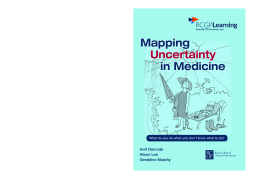
Additional Information
Book Details
Abstract
Uncertainty is the norm in medical practice, yet often gives rise to distress in clinicians, who fear they will make shameful or guilt inducing errors. This book offers a succinct method to clinicians for classifying uncertainty and finding the right skills to manage different types of uncertainty successfully. Every clinician experiences moments when 'they don't know what to do'. Modern medicine is increasingly complex and training has also become more complicated. The days of 'see one, do one, teach one' are over. Yet, both younger clinicians and senior practitioners describe uncertainty as one of the most challenging and stressful aspects of clinical work. If uncertainty is uncomfortable or threatening to individual practitioners, it also provides complex educational challenges. How can we learn to cope with uncertainty effectively ourselves? How can we teach others to understand and manage uncertainty? In this ground breaking book, the authors propose ways to cut through uncertainty, which is explored as an inevitable (and even desirable) component of clinical practice. A Map of Uncertainty in Medicine (MUM) is used to classify uncertainty and to define the skills that will help find a way though practical difficulties. It is always good to have your MUM with you in a tricky situation!
Certainty in medicine is an illusion, just as it is in everyday life. Keep this book by you - it will make sense of your uncertainties. Amanda Howe, foreword.
Table of Contents
| Section Title | Page | Action | Price |
|---|---|---|---|
| Contents | v | ||
| Foreword | vii | ||
| Preface | ix | ||
| About the authors | xiii | ||
| Acknowledgements | xv | ||
| Part I: Uncertainty in medicine | 1 | ||
| 1: Thinking about uncertainty in medical practice | 5 | ||
| 2: How to use this book | 11 | ||
| Part II: Mapping uncertainty in medicine | 21 | ||
| The Analysing Quadrant | 25 | ||
| 3: Introduction to uncertainty in the Analysing Quadrant | 27 | ||
| 4: Functional ways through uncertainty in the Analysing Quadrant | 41 | ||
| 5: The clinical setting, assessment and teaching methods for uncertainty in the Analysing Quadrant | 63 | ||
| The Networking Quadrant | 69 | ||
| 6: Introduction to uncertainty in the Networking Quadrant | 71 | ||
| 7: Functional ways through uncertainty in the Networking Quadrant | 77 | ||
| 8: The clinical setting, assessment and teaching methods for uncertainty in the Networking Quadrant | 95 | ||
| The Negotiating Quadrant | 99 | ||
| 9: Introduction to uncertainty in the Negotiating Quadrant | 101 | ||
| 10: Functional ways through uncertainty in the Negotiating Quadrant | 105 | ||
| 11: The clinical setting, assessment and teaching methods for uncertainty in the Negotiating Quadrant | 131 | ||
| The Team-working Quadrant | 135 | ||
| 12: Introduction to uncertainty in the Team-working Quadrant | 137 | ||
| 13: Functional ways through uncertainty in the Team-working Quadrant | 143 | ||
| 14: The clinical setting, assessment and teaching methods for uncertainty in the Team-working Quadrant | 165 | ||
| Part III: Mapping the psychology of uncertainty | 171 | ||
| 15: The psychological themes that underpin clinicians’ responses to uncertainty | 175 | ||
| 16: Mapping the psychology of uncertainty against the Analysing, Networking, Negotiating and Team-working Quadrants | 187 | ||
| Part IV: Mapping uncertainty in medical training | 207 | ||
| 17: Training clinicians to deal with uncertainty | 211 | ||
| 18: Assessment using the Map of Uncertainty in Medicine | 219 | ||
| 19: Educational methods for training for uncertainty | 227 | ||
| 20: Educational skills for uncertainty in training | 237 | ||
| 21: Learning about uncertainty | 249 | ||
| Part V: Exploring uncertainty from the patient’s perspective | 261 | ||
| 22: The impact of uncertainty on patients | 265 | ||
| 23: Mapping uncertainty from the patient’s perspective | 277 | ||
| 24: Conclusion | 299 | ||
| Index | 307 |
